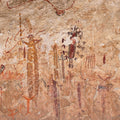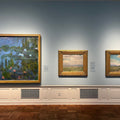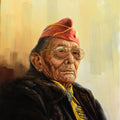Charles Gaines' Arizona Cottonwoods
By Chadd Scott on
Cottonwood trees have been a favored subject for painters across the West and Southwest since the Taos Society of Artists arrived in northern New Mexico in the early 20th century. They’ve never been painted like this before.
Charles Gaines (b. 1944) has been a leading figure in conceptual art since the 1970s. His artworks are best known for their use of an intricate grid and numbers system overlayed on photographs – thousands of tiny squares with numbers inside.
Gaines was invited to visit the Sonoran Desert by the Barrow Neurological Institute in Phoenix. The Institute wanted to acquire an example from Gaines’ ongoing “Numbers and Trees” series and offered to host him, allowing the artist to spend time in the landscape thinking about it. The results can be seen at the Pheonix Art Museum during “Charles Gaines: Numbers and Trees (Arizona Series),” on view through July 20, 2025.
“He's typically interested in large, old growth trees that can be singled out in the landscape because of the way he composes them,” Olga Viso, The Selig Family Chief Curator and Director of Curatorial Affairs at the Phoenix Art Museum, said. “They’re singular, distinctive trees, and trees that carry all kinds of history of place and cultural histories… rich cultural content and meaning for people in those places.”
Previous “Numbers and Trees” subjects from the L.A.-based artist go all the way back to walnut trees in the 70s, and include palm trees in Palm Canyon, CA, Central Park trees, London Trees, and pecan trees from his hometown of Charleston, SC. Following the Arizona cottonwoods, he visited Tanzania to produce baobab tree artworks.
Gaines photographed old growth cottonwood trees along a riparian area south of Tucson for his “Arizona Series.”
“Why not pick a saguaro cactus (to depict instead of a cottonwood) which you may not normally associate with the desert,” Viso asked rhetorically. “They're a keystone species in the desert and an indicator of water in the barren landscape.”

Charles Gaines, ‘Numbers and Trees: Arizona Series 1, Tree #3, Agua Caliente,’ 2023. Acrylic sheet, acrylic paint, photograph, 3 parts. Unique. Overall: 241.6 x 335.9 x 15.2 cm / 95 1/8 x 132 1/2 x 6 inches. © Charles Gaines. Courtesy the artist and Hauser & Wirth. Photo: Keith Lubow.
The Process
Gaines’ process begins with black and white photography. In the finished pieces – large plexiglass boxes recalling vitrines, sometimes 10 feet or more across – Gaines’ photographs sit on the back.
“When he decides he's going to start a series, he creates a set of rules for making,” Viso said. “Think about other conceptual artists like Sol LeWitt who would make his wall drawings by creating certain parameters of rules.”
Gaines then translates the analog photographic tree image onto an abstracted grid on the plexiglass surface. He assigns a random color to each tree.
For the “Arizona Series,” he photographed eight individual trees. Each plexiglass box has a different tree photograph in the background.
“He plots the first tree, and then in the second one, he plots the second tree on top of the first tree. As you move through the series, by the time you get to number eight, you have a plotting of eight different trees and eight different colors along this grid,” Viso explained. “The color blending that happens as the trees overlap or don't overlap create these unexpected patterns and colors and layering within the plexiglass. This surprise and the mixing of colors (allows) you to see the individuality of each tree.”
Moving through the series, each tree carries traces and memories of those that came before.
“Let's say it's tree number three. You have the black and white photograph of tree number three in the back, then on top, you've got a plotting for tree number one, tree number two, and tree number three,” Viso said. “As you get to eight, you've got eight (trees) plotted, but the most recent tree on top is the photograph that you have behind.”

Charles Gaines, ‘Numbers and Trees: Arizona Series 1, Tree #4, Tonto,’ 2023 (detail). Acrylic sheet, acrylic paint, photograph, 3 parts. Unique. Overall: 241.6 x 335.9 x 14.6 cm / 95 1/8 x 132 1/2 x 5 3/4 inches. © Charles Gaines. Courtesy the artist and Hauser & Wirth. Photo: Keith Lubow.
The numbers in the tiny square tiles emanate from a vertical line in the middle of each tree designated as zero. As Gaines moves across to the right and left, he counts, literally, numbers – 1, 2, 3, 4, 5, and so on – all the way across until there’s no more tree image. Numbers sometimes range into the hundreds. The numbers are only assigned to spaces with an image of the tree.
At the Phoenix Art Museum, the entire eight work “Arizona Series” is presented together.
“Because his works are large scale – these box vitrines are huge triptychs in this case – rarely can you see one entire series presented in its totality. That you can see one through eight and see his methodical process, it demystifies his process of production,” Viso said. “It’s a special opportunity to see a series in its totality. When you can actually see it broken down, (one through eight), you really appreciate the intricacy of his process and the visual power of these objects in person and how they're made.”
What’s the point? Why discard the freedom of the brush for rules?
This traces back to Gaines’ roots in the conceptual art movement of the 70s and artists at the time centering the idea of an artwork over its aesthetics. The idea behind the piece was more important than how it looked upon completion. Gaines and his conceptual art contemporaries purposefully worked to remove the “hand” of the artist – the biases and perspectives and subjectivity – from the process of making art.
“His whole practice has been about questioning the idea of individual subjectivity. This idea that subjectivity is always informed by your class in life, your privilege, your education, your history, all those things go into determining how you see the world, and how present the world,” Viso explained. “That is what Western art (art descending from Greece and Rome, not art of the American West) has always privileged. Conceptual artists are trying to remove this idea of the ‘hand’ and this idea of the sublime in art making.”
Subjectivity and the sublime, two bedrock features of Western art – art of the American West – going back to Bierstadt and Moran.
Art can’t get much more Western than cottonwood trees; Charles Gaines allows us to see the trees, and the genre, in a different light.



